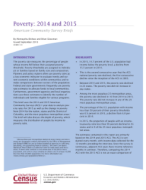Poverty: 2014 and 2015
Poverty: 2014 and 2015
Introduction
The poverty rate measures the percentage of people whose income fell below their assigned poverty threshold. Poverty thresholds are assigned to individuals or families based on family size and composition. Planners and policy makers often use poverty rates as a key economic indicator to evaluate trends and current economic conditions within communities and to make comparisons between sectors of the population. Federal and state governments frequently use poverty rate estimates to allocate funds to local communities. Furthermore, government agencies and local organizations use these estimates to identify the number of individuals and families eligible for various programs.
This brief uses the 2014 and 2015 American Community Surveys (ACS) 1-year data to analyze poverty rates for 2015 as well as the change in poverty from 2014 for the nation, states and the District of Columbia, and the most populous metropolitan areas.1 The brief will also discuss the depth of poverty, which measures the distribution of people by income-to-poverty ratio.
__________
1 Metropolitan and micropolitan statistical areas (metro and micro areas) are geographic entities delineated by the Office of Management and Budget (OMB) for use by federal statistical agencies in collecting, tabulating, and publishing federal statistics. The term Core Based Statistical Area (CBSA) is a collective term for both metro and micro areas. A metro area contains a core urban area of 50,000 or more population, and a micro area contains an urban core of at least 10,000 (but less than 50,000) population. For more information see <www.census.gov/programs-surveys/metro-micro.html>.
Others in Series
Publication
Publication
Publication




